Global Energy Trajectories: Innovation-Driven Pathways to Future Development
Abstract
1. Introduction
2. Research Design and Research Methodology
3. Theoretical Background
3.1. The Main Global Transformations of World Development
3.1.1. Demographic Transformation
3.1.2. Energy Transition
3.2. Global Trends of the Past Period and Unlearned Lessons of Yesterday
4. Energy Transition Forecasts and Prediction
4.1. Energy Transition in Neural Network Forecast of Future Energy Consumption
4.2. Energy Transition as a New Quality of World Energy Development
4.3. Main Laws of the Global Energy Transition
4.4. Interrelation of Global Transitions and Global Technological Transition Patterns
4.5. Neural Network Forecast of Energy Density, Space as a Space of New Opportunities for Energy Development
4.6. Global Transport and Communications Transition
5. Forecast Contour of Future Energy
Integrating the ‘Energy-Density Law’ with IAM Pathways and Socio-Technical Transition Theory
6. Conclusions
Author Contributions
Funding
Data Availability Statement
Conflicts of Interest
References
- Trimech, A. Exploring the Interplay of Renewable Energy and Carbon Dioxide Emissions across US Sectors through Wavelet Approach. Environ. Prog. Sustain. Energy 2024, 43, e14454. [Google Scholar] [CrossRef]
- Pokazeev, K.V.; Solovyev, D.A. Renewable Energy Transition: Timelines and Prospects in the Context of Climate Change and Sustainable Development. Physical and Mathematical Modeling of Earth and Environment Processes; Karev, V., Ed.; Springer Nature: Cham, Switzerland, 2025; pp. 198–205. [Google Scholar]
- Ramya, M.; Ranjitha, U.N.; Dalal, Y. Forecasting Global Energy Consumption Trends: A Statistical Analysis of Low-Carbon Transition Using ARIMA. In Proceedings of the 3rd International Conference on Communication, Control, and Intelligent Systems, CCIS 2024, Marutha, India, 6–7 December 2024; pp. 1–6. [Google Scholar] [CrossRef]
- Mykhailyshyn, K.; Polyanska, A.; Psyuk, V.; Antoniuk, O. How to Achieve the Energy Transition Taking into Account the Efficiency of Energy Resources Consumption. In 8th International Conference “Physical & Chemical Geotechnologies” 2024—Innovations in Mining and Energy; Dychkovskyi, R., Dyczko, A., Borojević Šoštarić, S., Eds.; E3S Web Conf.; Edpsciences: Dnipro, Ukraine; Krakow, Poland; Dubrovnik, Croatia, 2024; Volume 567, p. 01026. ISBN 9798331303242. [Google Scholar] [CrossRef]
- Gielen, D.; Boshell, F.; Saygin, D.; Bazilian, M.D.; Wagner, N.; Gorini, R. The Role of Renewable Energy in the Global Energy Transformation. Energy Strategy Rev. 2019, 24, 38–50. [Google Scholar] [CrossRef]
- Vallarta-Serrano, S.I.; Santoyo-Castelazo, E.; Santoyo, E.; Ramirez-Mendoza, R.A.; Bustamante-Bello, R.; Beltrán-Rodríguez, L. Scenarios of Sustainable Energy Transition towards the Decarbonisation of the Road Transport Sector: A Case Study for Mexico. Renew. Sustain. Energy Rev. 2025, 212, 115341. [Google Scholar] [CrossRef]
- Bhattacharyya, R. Changing Patterns of Energy Use and Its Linkage With Some Macroeconomic Variables in India and China. In Research Anthology on Clean Energy Management and Solutions; Information Resources Management Association, Ed.; IGI Global: Hershey, PA, USA, 2021; pp. 1615–1633. [Google Scholar] [CrossRef]
- Demircioğlu, M.; Eşİyok, S. Energy Consumption Forecast of Turkey Using Artificial Neural Networks from a Sustainability Perspective. Int. J. Sustain. Energy 2022, 41, 1127–1141. [Google Scholar] [CrossRef]
- Mastepanov, A.M. The Future of the Oil Industry in the Face of Energy Transition. View Analysis and Ratings of Foreign Experts. Neft. Khozyaystvo—Oil Ind. 2020, 2020, 10–14. [Google Scholar] [CrossRef]
- Garcier, R.J. Consuming Energy. In Consuming the Environment; Hird, M.J., Ed.; SCORAI Studies in Sustainable Consumption; Routledge: Abingdon, UK, 2025; pp. 38–49. ISBN 978-1-03-253536-4. [Google Scholar] [CrossRef]
- Johnstone, I.M. EROI Hierarchy of Society. Available online: https://www.issuesofsustainability.org/helpndoc-content/EROIHierarchyofSociety.html (accessed on 27 June 2025).
- Hall, C.A.S.; Lambert, J.G.; Balogh, S.B. EROI of Different Fuels and the Implications for Society. Energy Policy 2014, 64, 141–152. [Google Scholar] [CrossRef]
- Pali, F.; Dsouza, R.; Ryu, Y.; Oishee, J.; Aikkarakudiyil, J.; Gaikwad, M.A.; Norouzzadeh, P.; Buckner, S.; Rahmani, B. Energy Transitions over Five Decades: A Statistical Perspective on Global Energy Trends. Computers 2025, 14, 190. [Google Scholar] [CrossRef]
- Jenko, J.; Costa, J.P. Using Temporal Fusion Transformer Predictions to Maximise Use of Renewable Energy Sources. In Proceedings of the 2024 International Workshop on Artificial Intelligence and Machine Learning for Energy Transformation, AIE 2024—Proceedings, Vaasa, Finland, 20–22 May 2024; Institute of Electrical and Electronics Engineers Inc.: Vaasa, Finland, 2024; pp. 1–10, ISBN 979-835036496-5. [Google Scholar] [CrossRef]
- Koprinska, I.; Wu, D.; Wang, Z. Convolutional Neural Networks for Energy Time Series Forecasting. In Proceedings of the International Joint Conference on Neural Networks (IJNN)—Proceedings, Rio de Janeiro, Brazil, 8–13 July 2018; Volume 2018, pp. 1–8. [Google Scholar] [CrossRef]
- Romero, A.F.; Quilumba, F.L.; Arcos, H.N. Short-Term Active Power Forecasting of a Photovoltaic Power Plant Using an Artificial Neural Network. In Proceedings of the 2017 IEEE Second Ecuador Technical Chapters Meeting (ETCM), Salinas, Euador, 16–20 October 2017; Volume 2017, pp. 1–5. [Google Scholar] [CrossRef]
- Usman, M.; Ali Khan, Z.; Khan, I.U.; Javaid, S.; Javaid, N. Data Analytics for Short Term Price and Load Forecasting in Smart Grids Using Enhanced Recurrent Neural Network. In Proceedings of the ITT 2019—Sixth Information Technology Trends: Emerging Technologies Blockchain and IoT, Ras Al Khaiman, United Arab Emirates, 20–21 November 2019; pp. 84–88. [Google Scholar] [CrossRef]
- Hamzaçebi, C.; Kutay, F. Electric Consumption Forecasting of Turkey Using Artificial Neural Networks up to Year 2010. J. Fac. Eng. Archit. Gazi Univ. 2004, 19, 227–233. Available online: https://dergipark.org.tr/tr/download/article-file/76153 (accessed on 7 July 2025).
- Madhugeeth, K.P.M.; Premaratna, H.L. Forecasting Power Demand Using Artificial Neural Networks for Sri Lankan Electricity Power System. In Proceedings of the 2008 IEEE Region 10 and the Third international Conference on Industrial and Information Systems, Kharagpur, India, 8–10 December 2008; pp. 1–6. [Google Scholar] [CrossRef]
- Lopez-Leyva, J.A.; Barrera-Silva, C.; Sarmiento-Leyva, L.F. Advanced Power Generation & Demand Forecasting Considering the Complete Energy Matrix Using an Artificial Neural Network. In Proceedings of the 2021 IEEE International Conference on Engineering Veracruz (ICEV)—Proceedings, Boca del Río, Veracruz, Mexico, 25–28 October 2021; pp. 1–5. [Google Scholar] [CrossRef]
- Asadian, S.; Nazari-Heris, M. Short-Term Electric Load Forecasting Using ESN Neural Networks. In Artificial Intelligence in the Operation and Control of Digitalized Power Systems; Azad, S., Nazari-Heris, M., Eds.; Power Systems; Springer: Cham, Switzerland, 2024; Volume F3666, pp. 157–183. [Google Scholar] [CrossRef]
- Paoli, C.; Voyant, C.; Muselli, M.; Nivet, M.-L. Use of Exogenous Data to Improve an Artificial Neural Networks Dedicated to Daily Global Radiation Forecasting. In Proceedings of the 2010 9th Conference on Environment and Electrical Engineering, EEEIC 2010, Prague, Czech Republic, 16–19 May 2010; pp. 49–52. [Google Scholar] [CrossRef]
- Ichikawa, T.; Ichiyanagi, K.; Yukita, K.; Goto, Y. Forecasting Method of Time Series of Solar Energy and Wind Power by Using Wide Meteorological Data. In Proceedings of the 10th WSEAS/IASME International Conference on Electric Power Systems, High Voltages, Electric Machines, POWER’10, 6th WSEAS International Conference on Remote Sensing, REMOTE’10—Proceedings, Takizawa, Japan, 4–6 October 2010; pp. 33–38, ISBN 978-960-474-233-2. [Google Scholar]
- Reşat, H.G. Design and Development of Hybrid Forecasting Model Using Artificial Neural Networks and ARIMA Methods for Sustainable Energy Management Systems: A Case Study in Tobacco Industry. J. Fac. Eng. Archit. Gazi Univ. 2020, 35, 1129–1140. [Google Scholar] [CrossRef]
- Oreshkin, B.N.; Dudek, G.; Pełka, P.; Turkina, E. N-BEATS Neural Network for Mid-Term Electricity Load Forecasting. Appl. Energy 2021, 293, 116918. [Google Scholar] [CrossRef]
- Kugaevskikh, A.V.; Muromtsev, D.I.; Kirsanova, O.V. Clssical Methods of Machine Training; ITMO University: St. Petersburg, Russia, 2022; Available online: https://books.ifmo.ru/file/pdf/3075.pdf (accessed on 10 June 2025).
- Devezas, T.; Tick, A.; Sarygulov, A.; Rukina, P. The Slow Pace of Green Transformation: Underlying Factors and Implications. Energies 2024, 17, 4789. [Google Scholar] [CrossRef]
- Ageev, A.I.; Belogoriev, A.M.; Bushuev, V.V.; Golubev, V.S.; Gromov, A.I.; Dobrocheev, O.V.; Klepach, A.N.; Muntiyan, V.I.; Plakitkin, B.A.; Sokotushchenko, V.N.; et al. On the Way to Space-Planetary Civilization; Energia Publishing House: Moscow, Russia, 2023; ISBN 978-5-98908-493-7. Available online: https://zenodo.org/record/7684441 (accessed on 10 June 2025).
- Plakitkin, Y. Energy and World Development Forecast in XXI Century. AIP Conf. Proc. 2023, 2552, 080032. [Google Scholar] [CrossRef]
- Worldometer. World Population Clock: 8.2 Billion People (LIVE, 2025)—Worldometer. Available online: https://www.worldometers.info/world-population/ (accessed on 27 January 2025).
- Population Reference Bureau. World Population Data Sheet 2023. Available online: https://2023-wpds.prb.org/wp-content/uploads/2023/12/2023-World-Population-Data-Sheet-Booklet.pdf (accessed on 5 June 2025).
- Energy Institute. Statistical Review of World Energy 2024. 2024. Available online: https://www.energyinst.org/statistical-review/home (accessed on 5 June 2025).
- Pavlov, M. Population Projection in the World’s Countries for 2100. Available online: http://en.ostranah.ru/_lists/population.php?id=2100 (accessed on 10 June 2025).
- Goujon, A.; Samir, K.C. Population and Human Capital Projections (SSP 2023). Available online: http://iiasa.ac.at/models-tools-data/ssp-2023 (accessed on 10 June 2025).
- IHME. Fertility Forecasts and Their Implications for Population Growth|Institute for Health Metrics and Evaluation. Available online: https://www.healthdata.org/research-analysis/library/fertility-forecasts-and-their-implications-population-growth (accessed on 10 June 2025).
- UN. UN Population Division Data Portal. Available online: https://population.un.org/dataportal/home?df=c5505b8a-5073-4528-a72a-83aed5a80dc1 (accessed on 10 June 2025).
- Korotaev, A.V.; Khalturina, D.A.; Malkov, A.S.; Bozhevolnov, Y.V.; Kobzeva, S.V.; Zinkina, Y.V. Mathematical Modeling and Forecasting Russia’s Demographic Future: Five Scenarios. In Laws of History: Mathematical Modeling and Forecasting of World and Regional Development; URSS: Moscow, Russia, 2010; pp. 227–265. ISBN 9785382012520. Available online: https://web.archive.org/web/20160601122425/http://cliodynamics.ru/download/3_3N08Glava6.pdf (accessed on 10 June 2025).
- Kapitza, S.P. Global Population Blow-up and After: The Demographic Revolution and Sustainable Development. Bull. Georgian Natl. Acad. Sci. 2009, 3, 5–12. Available online: http://www.science.org.ge/old/3-1/Kapitza.pdf (accessed on 6 June 2025).
- Kapitza, S.P. Global Population Blow-Up and After. The Demographic Revolution and Information Society (A Report to the Club of Rome and the Global Marshall Plan Initiative); Tolleranza: Hamburg, Germany, 2006; ISBN 978-3-9809723-5-2. Available online: https://www.clubofrome.org/publication/global-population-blow-up-and-after-2006/ (accessed on 10 June 2025).
- Kapitsa, S.P.; Kurdyumov, S.P.; Malinetsky, G.G. Synergetics and Future Forecasts; URSS: Moscow, Russia, 1997; Available online: https://reallib.org/reader?file=482191 (accessed on 7 June 2025).
- Kapitza, S.P. General Theory of Human Growth: How Many People Lived, Lives and Will Live on Earth; Nauka: Moscow, Russia, 1999; Available online: https://litresp.ru/chitat/ru/%D0%9A/kapica-sergej/obschaya-teoriya-rosta-chelovechestva# (accessed on 8 June 2025).
- Akaev, A.A.; Sadovnichii, V.A. A Mathematical Model to Predict Global Demographic Dynamics in the Age of Intelligent Machines. Her. Russ. Acad. Sci. 2022, 92, 636–642. [Google Scholar] [CrossRef]
- Akaev, A.A.; Sadovnichii, V.A. Mathematical Model of Population Dynamics with the World Population Size Stabilizing about a Stationary Level. Dokl. Math. 2010, 82, 978–981. [Google Scholar] [CrossRef]
- Kapitza, S.P. On the Theory of Global Population Growth. Phys.-Usp. 2010, 53, 1287. [Google Scholar] [CrossRef]
- Kak, S. The Age of Artificial Intelligence; Garuda Prakashan Pvt. Ltd.: Haryana, India, 2025; ISBN 9798885752138. [Google Scholar]
- Dzerzhinsky, R.I.; Zausailov, A.S.; Vorontsov, A.A. Modelling World Population Dynamics. In Data Science and Intelligent Systems; Silhavy, R., Silhavy, P., Prokopova, Z., Eds.; Lecture Notes in Networks and Systems; Springer International Publishing: Cham, Switzerland, 2021; Volume 231, pp. 423–432. ISBN 978-3-030-90320-6. [Google Scholar]
- Pellecchia, P. The Future of AI. Extinction or Death of the Human? Sci. Fides 2025, 13, 39–55. [Google Scholar] [CrossRef]
- Energy Institute. Statistical Review of World Energy; Energy Institute: London, UK, 2024; p. 73. Available online: https://www.energyinst.org/statistical-review#regional-overview (accessed on 27 January 2025).
- BP. Bp Energy Outlook 2024; BP: London, UK, 2024; p. 107. Available online: https://www.bp.com/content/dam/bp/business-sites/en/global/corporate/pdfs/energy-economics/energy-outlook/bp-energy-outlook-2024.pdf (accessed on 27 January 2025).
- Do, T.N.; Burke, P.J.; Nguyen, H.N.; Overland, I.; Suryadi, B.; Swandaru, A.; Yurnaidi, Z. Vietnam’s Solar and Wind Power Success: Policy Implications for the Other ASEAN Countries. Energy Sustain. Dev. 2021, 65, 1–11. [Google Scholar] [CrossRef]
- Dong, X. Monthly China Energy Update|2023 China Electricity Mix Yearly Review; Climate Energy Finance: Sydney, Australia, 2024; p. 7. Available online: https://climateenergyfinance.org/wp-content/uploads/2024/01/MONTHLY-CHINA-ENERGY-UPDATE-_-2023-China-Electricity-Mix-Yearly-Review-1-1.pdf (accessed on 27 January 2025).
- Government of India. Energy Statistics India 2023; Energy Statistics Division (ESD): New Delhi, India, 2023; p. 115.
- National Bureau of Statistics of China. Stastical Communiqué of the People’s Republic of China on the 2023 National Economic and Social Development. Available online: https://www.stats.gov.cn/english/PressRelease/202402/t20240228_1947918.html (accessed on 30 April 2024).
- Do, T.N.; Burke, P.J. Phasing out Coal Power in a Developing Country Context: Insights from Vietnam. Energy Policy 2023, 176, 113512. [Google Scholar] [CrossRef]
- Plakitkina, L.S.; Plakitkin, Y.A.; Dyachenko, K.I. Current Trends and a Forecast of Coal Industry Development in Russia and Worldwide in Conditions of the World Economy Transformation Part I. Existing Trends in Coal Industry Operation in Russia and World-Wide since the Beginning of the 21st Century. Ugol’ 2024, 44–51. [Google Scholar] [CrossRef]
- IEA. Net Zero by 2050—A Roadmap for the Global Energy Sector; IEA: Paris, France, 2024; p. 224. Available online: https://www.iea.org/reports/net-zero-by-2050 (accessed on 27 January 2025).
- IEA. Renewables 2020—Analysis and Forecast to 2025; IEA: Paris, France, 2020; p. 172. Available online: https://iea.blob.core.windows.net/assets/1a24f1fe-c971-4c25-964a-57d0f31eb97b/Renewables_2020-PDF.pdf (accessed on 27 January 2025).
- IEA. Renewables—Energy System. Available online: https://www.iea.org/energy-system/renewables (accessed on 23 May 2024).
- Our World in Data Share of Electricity Production from Renewables 2023. Available online: https://ourworldindata.org/grapher/share-electricity-renewables (accessed on 15 August 2024).
- UNEP. Renewables 2022 Global Status Report; UN: New York, NY, USA, 2022; Available online: https://www.unep.org/resources/report/renewables-2022-global-status-report (accessed on 27 January 2025).
- World Economics. GDP Rankings 2025. Available online: https://www.worldeconomics.com/Indicator-Data/Economic-Size/Revaluation-of-GDP.aspx (accessed on 20 May 2024).
- Varga, J.; Csiszárik-Kocsir, Á. The Impact of Human Activity on Environmental Elements Based on the Results of a Primary Research. Acta Polytech Hung 2024, 21, 147–168. [Google Scholar] [CrossRef]
- Georgescu, I.M.; Ashhab, S.; Nori, F. Quantum Simulation. Rev. Mod. Phys. 2014, 86, 153–185. [Google Scholar] [CrossRef]
- Ladd, T.D.; Jelezko, F.; Laflamme, R.; Nakamura, Y.; Monroe, C.; O’Brien, J.L. Quantum Computers. Nature 2010, 464, 45–53. [Google Scholar] [CrossRef] [PubMed]
- Peruzzo, A.; McClean, J.; Shadbolt, P.; Yung, M.-H.; Zhou, X.-Q.; Love, P.J.; Aspuru-Guzik, A.; O’Brien, J.L. A Variational Eigenvalue Solver on a Photonic Quantum Processor. Nat. Commun. 2014, 5, 4213. [Google Scholar] [CrossRef]
- Politi, A.; Matthews, J.; Thompson, M.G.; O’Brien, J.L. Integrated Quantum Photonics. IEEE J. Select. Top. Quantum Electron. 2009, 15, 1673–1684. [Google Scholar] [CrossRef]
- Plakitkin, Y. New Technological Track of the World Economy and Its Impact on the Vector of Global Energy Development. Russ. Dev. Trends Prospect. 2011, 6, 714–716. Available online: https://cyberleninka.ru/article/n/novyy-tehnologicheskiy-trek-mirovoy-ekonomiki-i-ego-vliyanie-na-vektor-razvitiya-mirovoy-energetiki/viewer (accessed on 10 June 2025).
- Bouramdane, A.-A. Morocco’s Path to a Climate-Resilient Energy Transition: Identifying Emission Drivers, Proposing Solutions, and Addressing Barriers. Sci. Technol. Energ. Transit. 2024, 79, 26. [Google Scholar] [CrossRef]
- Tan, N.; Harrison, J.; Howells, M. Comparing Long-Term Power Sector Pathways in Viet Nam: A Simple Cost-Optimization Approach with OSeMOSYS. Energies 2024, 17, 6158. [Google Scholar] [CrossRef]
- Allan, G.; McGregor, P.G.; Swales, J.K.; Turner, K. Impact of Alternative Electricity Generation Technologies on the Scottish Economy: An Illustrative Input—Output Analysis. Proc. Inst. Mech. Eng. Part A J. Power Energy 2007, 221, 243–254. [Google Scholar] [CrossRef]
- Trishna, S. Calorific Value of Fuels: Definition, How to Calculate, Liquid Fuel and Gaseous Fuels|Thermal Engineering. Eng. Notes India 2018. Available online: https://www.engineeringenotes.com/thermal-engineering/calorific-value-of-fuel/calorific-value-of-fuels-definition-how-to-calculate-liquid-fuel-and-gaseous-fuels-thermal-engineering/51356 (accessed on 20 April 2024).
- Boughn, S. Fritz Hasenöhrl and E = Mc2. Eur. Phys. J. H 2013, 38, 261–278. [Google Scholar] [CrossRef]
- Markovich, P.A. Strategic Tranformation f Russia’s Energy Sector: Challenges and Prospects/Cтpaтeгичeскaя Тpaнсфopмaция Энepгeтичeскoгo Ceктopa Рoссии: Bызoвы и Пepспeктивы. ЭH 2024, 8, 202–208. [Google Scholar] [CrossRef]
- Anufriev, I.E.; Khusainov, B.; Tick, A.; Devezas, T.; Sarygulov, A.; Kaimoldina, S. Mathematical Model for Assessing New, Non-Fossil Fuel Technological Products (Li-Ion Batteries and Electric Vehicle). Mathematics 2025, 13, 143. [Google Scholar] [CrossRef]
- Müller, G.; Parker, G. Experimental Investigation of the Atmospheric Steam Engine with Forced Expansion. Renew. Energy 2015, 75, 348–355. [Google Scholar] [CrossRef]
- Butz, J.S. Powerplants—Piston & Turbine. Fly. Mag. 1963, 73, 33–36, 102–104. [Google Scholar]
- Plakitkin, Y. Global Energy Transition and Modern World Transformations in Energy Development Forecasts. Energy Policy 2023, 8, 8–25. [Google Scholar] [CrossRef]
- WIPO. IP Facts and Figures 2024, 1st ed.; WIPO: Geneva, Switzerland, 2024; ISBN 978-92-805-3705-5. Available online: https://www.wipo.int/web-publications/ip-facts-and-figures-2024/index.html (accessed on 21 March 2024).
- Plakitkin, Y.; Plakitkina, L.; Diachenko, K. Energy of Yesterday and Tomorrow: Contours of Long-Term Development. Energy Policy 2024, 9, 10–31. [Google Scholar] [CrossRef]
- Schwab, K. The Fourth Industrial Revolution; Crown: Sydney, Australia, 2017; ISBN 978-1-5247-5887-5. [Google Scholar]
- Government of Japan. Report on the 5th Science and Technology Basic Plan; Council for Science, Technology and Innovation Cabinet Office, Government of Japan: Tokyo, Japan, 2015; p. 18. Available online: https://www8.cao.go.jp/cstp/kihonkeikaku/5basicplan_en.pdf (accessed on 20 April 2024).
- Government of Japan Society 5.0. Available online: https://www8.cao.go.jp/cstp/english/society5_0/index.html (accessed on 31 January 2025).
- i-scoop from Industry 4.0 to Society 5.0: The Big Societal Transformation Plan of Japan. Available online: https://www.i-scoop.eu/industry-4-0/society-5-0/ (accessed on 20 May 2024).
- US Department of Energy (DOE). Space-Based Solar Power. Energy.gov. 2014. Available online: https://www.energy.gov/articles/space-based-solar-power (accessed on 30 April 2024).
- Li, W. Overview on Space Solar Power Station. Adv. Astronaut. Sci. Technol. 2022, 5, 1–2. [Google Scholar] [CrossRef]
- Kurhan, M.; Kurhan, D.; Hmelevska, N. Enhancing Railway Section Capacity, during Expansion of the European Railway Network. Acta Polytech Hung 2025, 22, 159–171. [Google Scholar] [CrossRef]
- Railisa UIC Statistics. Railway Statistics Synopsis 2024. Available online: https://uic.org/IMG/pdf/railway_statistics_synopsis_2024web_1866037339.pdf (accessed on 21 January 2025).
- Statista Worldwide Maritime Trade—Transport Volume of Seaborne Trade from 1990 to 2021. Available online: https://www.statista.com/statistics/264117/tonnage-of-worldwide-maritime-trade-since-1990/ (accessed on 31 January 2025).
- Kharitonov, V.V.; Stoyanov, A.D. Potential for Nuclear Energy Development in Uzbekistan. Econ. Strateg. 2024, 1, 26–35. [Google Scholar] [CrossRef]
- IEA. World Energy Outlook 2022—Analysis; IEA: Paris, France, 2022; p. 524. Available online: https://www.iea.org/reports/world-energy-outlook-2022 (accessed on 10 June 2025).
- Loulou, R.; Remme, U.; Kanudia, A.; Lehtilä, A.; Goldstein, G. Documentation for the TIMES Model 2005. Available online: https://www.iea-etsap.org/docs/TIMESDoc-Intro.pdf (accessed on 1 August 2025).
- IEA. Global Energy and Climate Model Documentation 2024. 2024. Available online: https://iea.blob.core.windows.net/assets/a2aaddf1-a0f8-4ecb-8b20-31622423bc2e/GlobalEnergyandClimateModelDocumentation2024.pdf (accessed on 28 July 2025).
- Yurkov, S. Desperate Importance of Nuclear Renaissance for the Future of Japan. ES 2024, 193, 18–25. [Google Scholar] [CrossRef]
- Rosatom. Small Nuclear Power Plants. Available online: https://rosatom.ru/en/rosatom-group/small-nuclear-power-plants/ (accessed on 2 August 2025).
- Arvanitidis, A.I.; Talbot, P.; Gatsis, N.; Alamaniotis, M. Comprehensive Assessment of Deep Reinforcement Learning Approaches for Economic Dispatch in Nuclear-Driven Microgrids. Comput. Electr. Eng. 2025, 126, 110528. [Google Scholar] [CrossRef]
- Badakhshan, S.; Kaushik, H.D.; Zhang, J. Stochastic Optimization of Small Modular Reactor and Battery Sizing for Maritime Decarbonization Under Voyage Uncertainties. IEEE Trans. Transp. Electrif. 2025, 11, 1. [Google Scholar] [CrossRef]
- Paul, S.; Klimenka, M.; Duarte, F.; Crawford, C.; Gorman, C.; Ratti, C.; Buongiorno, J. When Cities Go Nuclear: Exploring the Applications of Nuclear Batteries Toward Energy Transformation. Urban Sci. 2024, 8, 226. [Google Scholar] [CrossRef]
- United Kingdom National Nuclear Laboratory. How a Space Battery Works; United Kingdom National Nuclear Laboratory: Warrington, UK, 2025; Available online: https://uknnl.com/customer-solutions/space-exploration/how-a-space-battery-works/ (accessed on 3 July 2025).
- Buongiorno, J.; Carmichael, B.; Dunkin, B.; Parsons, J.; Smit, D. Can Nuclear Batteries Be Economically Competitive in Large Markets? Energies 2021, 14, 4385. [Google Scholar] [CrossRef]
- Bartak, J.; Bruna, G.; Cognet, G. Economics of Small Modular Reactors: Will They MakeNuclear Power More Competitive? JEPE 2021, 15, 193–201. [Google Scholar] [CrossRef]
- World Nuclear Association. Nuclear Reactors and Radioisotopes for Space 2025. Available online: https://world-nuclear.org/information-library/non-power-nuclear-applications/transport/nuclear-reactors-for-space (accessed on 3 July 2025).
- Vining, C.; Bennett, G. Power for Science and Exploration: Upgrading the General-Purpose Heat Source Radioisotope Thermoelectric Generator (GPHS-RTG). In Proceedings of the 46th AIAA/ASME/SAE/ASEE Joint Propulsion Conference & Exhibit, Nashville, TN, USA, 25–28 July 2010; American Institute of Aeronautics and Astronautics: Washington, DC, USA, 2010; pp. 1–15. [Google Scholar] [CrossRef]
- Jarell, J. Nuclear Batteries with Potential. STR 2022, March, 20–23. Available online: https://str.llnl.gov/past-issues/march-2022/nuclear-batteries-potential (accessed on 3 July 2025).
- Tsiolkovskiy, K.E. Study of Outer Space by Reaction Devices; Mashinoastroyeniye: Moscow, Russia, 1967; Available online: http://archive.org/details/nasa_techdoc_19750021068 (accessed on 24 June 2025).
- Pathak, A.D.; Saha, S.; Bharti, V.K.; Gaikwad, M.M.; Sharma, C.S. A Review on Battery Technology for Space Application. J. Energy Storage 2023, 61, 106792. [Google Scholar] [CrossRef]
- Vigier, J.-F.; Freis, D.; Pöml, P.; Prieur, D.; Lajarge, P.; Gardeur, S.; Guiot, A.; Bouëxière, D.; Konings, R.J.M. Optimization of Uranium-Doped Americium Oxide Synthesis for Space Application. Inorg. Chem. 2018, 57, 4317–4327. [Google Scholar] [CrossRef]
- Fox, A. Zeno Power’s Nuclear Battery Tech: A Strategic Play in the Off-Grid Energy Revolution. AiInvest 2025. Available online: https://www.ainvest.com/news/zeno-power-nuclear-battery-tech-strategic-play-grid-energy-revolution-2506/ (accessed on 3 July 2025).
- Keldysch Research Center. Space Power Engineering. Available online: https://www.keldysh-space.ru/en/nasha-deyatelnost/raketno-kosmicheskaya-deyatelnost/kosmicheskaya-energetika/ (accessed on 24 June 2025).
- Anderson, L. Akademik Lomonosov: The Floating Power Plant. DevX 2023. Available online: https://www.devx.com/daily-news/akademik-lomonosov-the-floating-power-plant/ (accessed on 3 July 2025).
- Weyant, J.; Davidson, O.; Dowlatabadi, H.; Edmonds, J.; Grubb, M.; Parson, E.; Richels, R.; Rotmans, J.; Shukla, P.; Tol, R.; et al. Integrated Assessment of Climate Change: An Overview and Comparison of Approaches and Results. In Climate Change 1995: Economic and Social Dimensions of Climate Change; Cambridge University Press: New York, NY, USA, 1996; pp. 367–396. [Google Scholar]
- Clarke, L.; Edmonds, J.; Jacoby, H.; Pitcher, H.; Reilly, J.; Richels, R. Scenarios of Greenhouse Gas Emissions and Atmospheric Concentrations; Sub-Report 2.1A of Synthesis and Assessment Product 2.1 by the U.S. Climate Change Science Program and the Subcommittee on Global Change Research; Department of Energy, Office of Biological & Environmental Research: Washington, DC, USA, 2007; p. 154.
- O’Neill, B.C.; Kriegler, E.; Ebi, K.L.; Kemp-Benedict, E.; Riahi, K.; Rothman, D.S.; van Ruijven, B.J.; van Vuuren, D.P.; Birkmann, J.; Kok, K.; et al. The Roads Ahead: Narratives for Shared Socioeconomic Pathways Describing World Futures in the 21st Century. Glob. Environ. Change 2017, 42, 169–180. [Google Scholar] [CrossRef]
- Riahi, K.; van Vuuren, D.P.; Kriegler, E.; Edmonds, J.; O’Neill, B.C.; Fujimori, S.; Bauer, N.; Calvin, K.; Dellink, R.; Fricko, O.; et al. The Shared Socioeconomic Pathways and Their Energy, Land Use, and Greenhouse Gas Emissions Implications: An Overview. Glob. Environ. Change 2017, 42, 153–168. [Google Scholar] [CrossRef]
- Calvin, K.; Dasgupta, D.; Krinner, G.; Mukherji, A.; Thorne, P.W.; Trisos, C.; Romero, J.; Aldunce, P.; Barrett, K.; Blanco, G.; et al. IPCC, 2023: Climate Change 2023: Synthesis Report. Contribution of Working Groups I, II and III to the Sixth Assessment Report of the Intergovernmental Panel on Climate Change; Lee, H., Romero, J., Eds.; IPCC: Geneva, Switzerland, 2023. [Google Scholar]
- Asefi-Najafabady, S.; Villegas-Ortiz, L.; Morgan, J. The Failure of Integrated Assessment Models as a Response to ‘Climate Emergency’ and Ecological Breakdown: The Emperor Has No Clothes. Globalizations 2021, 18, 1178–1188. [Google Scholar] [CrossRef]
- Gambhir, A.; Butnar, I.; Li, P.-H.; Smith, P.; Strachan, N. A Review of Criticisms of Integrated Assessment Models and Proposed Approaches to Address These, through the Lens of BECCS. Energies 2019, 12, 1747. [Google Scholar] [CrossRef]
- Chaisson, E.J. The Natural Science Underlying Big History. Sci. World J. 2014, 2014, 384912. [Google Scholar] [CrossRef]
- Stern, D.I. The Role of Energy in Economic Growth; CCEP Working Paper 3.10; Centre for Climate Economics & Policy, Crawford School of Economics and Government, The Australian National University: Canberra, Australia, 2010; pp. 1–50. [Google Scholar] [CrossRef]
- Geels, F.W. Technological Transitions as Evolutionary Reconfiguration Processes: A Multi-Level Perspective and a Case-Study. Res. Policy 2002, 31, 1257–1274. [Google Scholar] [CrossRef]
- Schot, J.; Geels, F.W. Strategic Niche Management and Sustainable Innovation Journeys: Theory, Findings, Research Agenda, and Policy. Technol. Anal. Strateg. Manag. 2008, 20, 537–554. [Google Scholar] [CrossRef]
- Berkhout, F.; Smith, A.; Stirling, A. Chapter 3 Socio-Technological Regimes and Transition Contexts. System Innovation and the Transition to Sustainability: Theory, Evidence and Policy; Edward Elgar Publishing: Northampton, MA, USA, 2004; ISBN 978-1-84542-342-1. [Google Scholar]
- Smith, A.; Stirling, A. The Politics of Social-Ecological Resilience and Sustainable Socio-Technical Transitions. Ecol. Soc. 2010, 15, 11. [Google Scholar] [CrossRef]
- Bejan, A. Evolution in Thermodynamics. Appl. Phys. Rev. 2017, 4, 011305. [Google Scholar] [CrossRef]
- Chaisson, E.J. Energy Flows in Low-Entropy Complex Systems. Entropy 2015, 17, 8007–8018. [Google Scholar] [CrossRef]
- Kanger, L. Rethinking the Multi-Level Perspective for Energy Transitions: From Regime Life-Cycle to Explanatory Typology of Transition Pathways. Energy Res. Soc. Sci. 2021, 71, 101829. [Google Scholar] [CrossRef]
- Mizrahi, O.S.; Jahelka, P.; Gdoutos, E.; Brunet, J.; Ayling, A.; Fikes, A.; Wu, A.; Madonna, R.; Atwater, H.A.; Pellegrino, S.; et al. Space Solar Power Generation: A Viable System Proposal and Technoeconomic Analysis. Joule 2025, 9, 101928. [Google Scholar] [CrossRef]
- Navarro-Medina, F.; Aguado-Agelet, F.; Garcia-Luis, U.; Ulloa, C.; Orgeira-Crespo, P.; Camanzo-Mariño, A.; Dragos-Darau, V.; Maia, M.M.; Gomez-San-Juan, A.; Furtado, C.; et al. WiPTherm: A Novel Energy Harvesting Paradigm for CubeSats. In Proceedings of the 73rd International Astronautical Congress IAC (2022), Paris, France, 18–22 September 2022; International Astronautical Federation, IAF: Paris, France, 2022; Volume 2022. [Google Scholar]
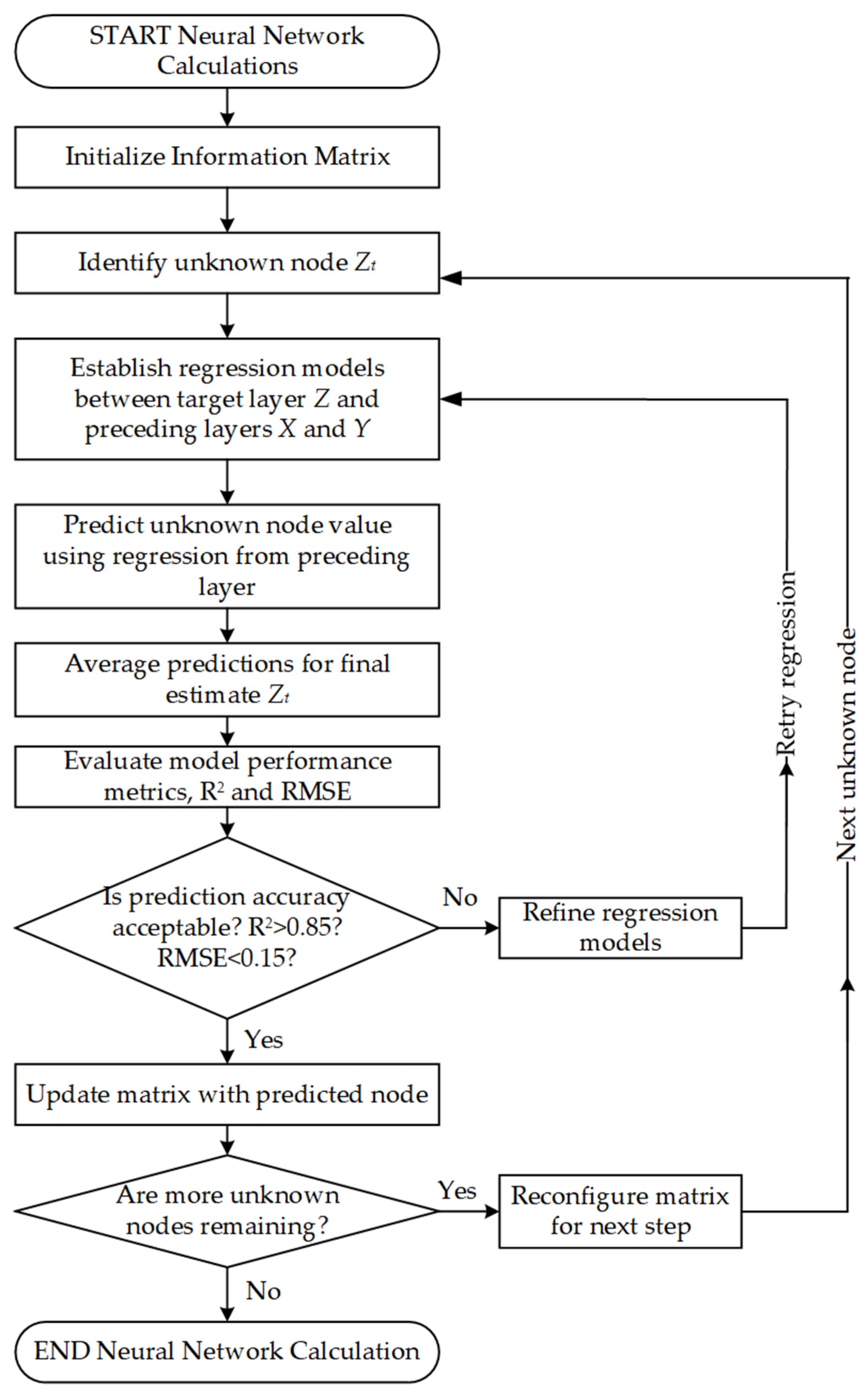





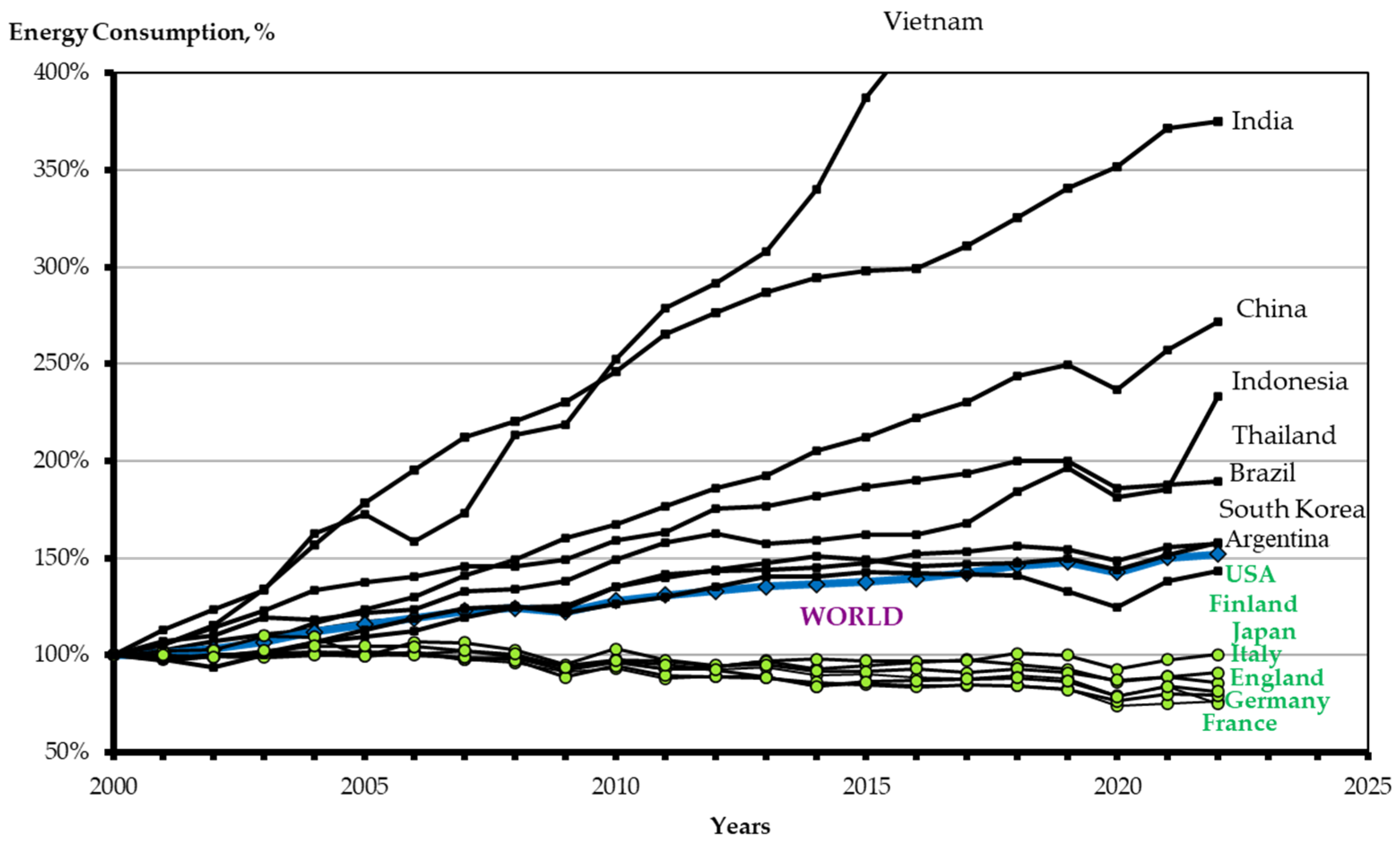


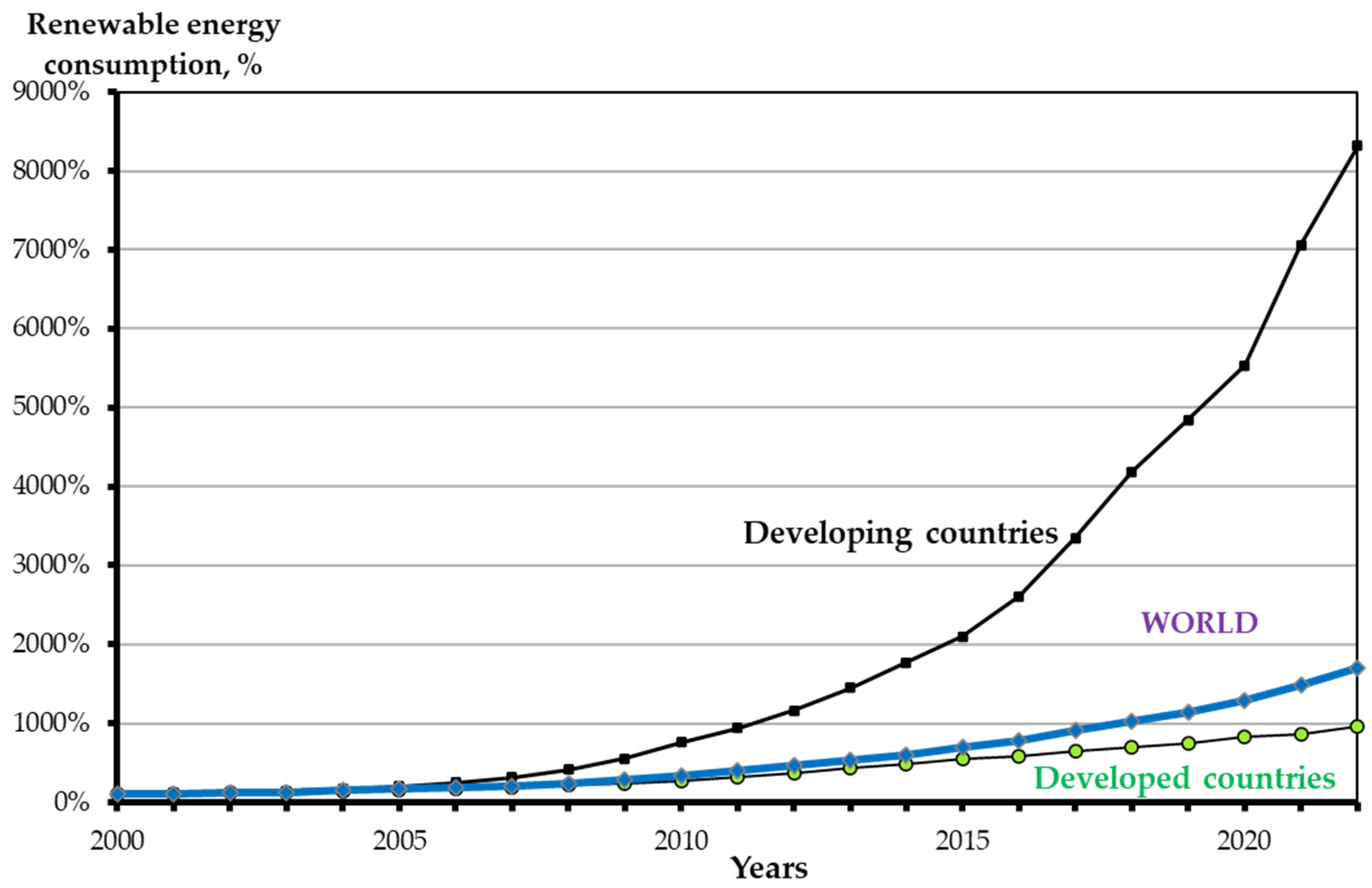


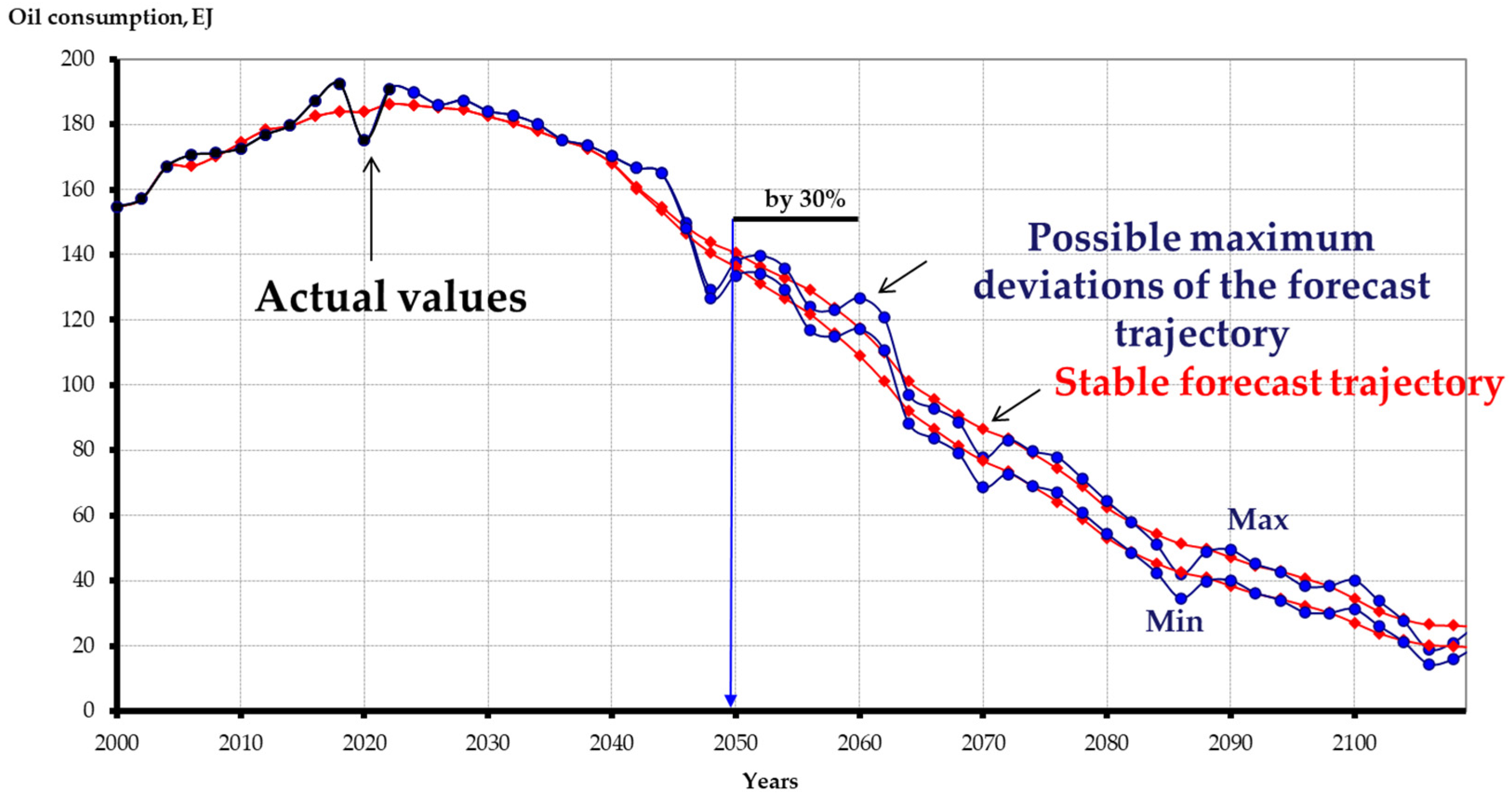
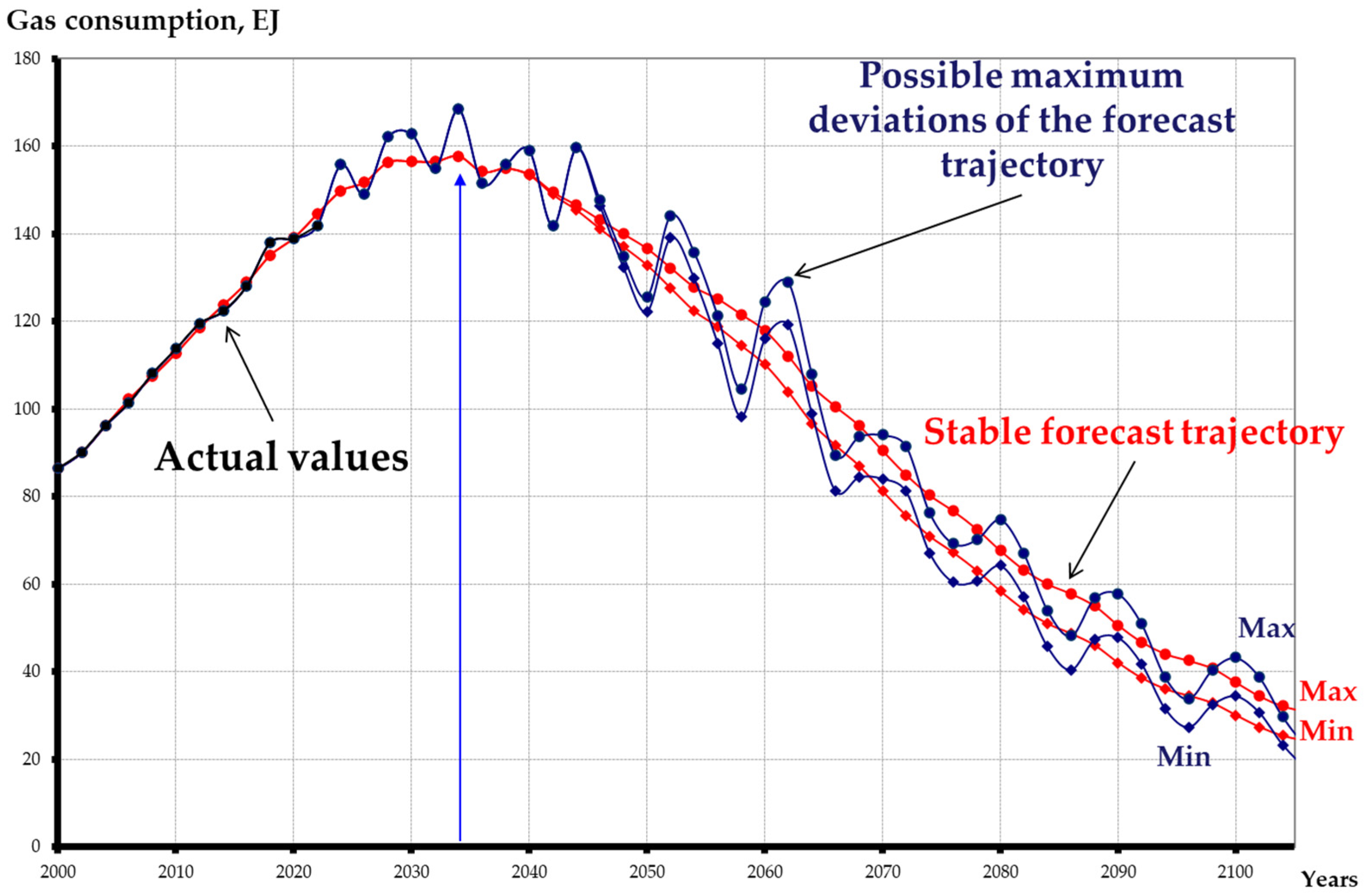

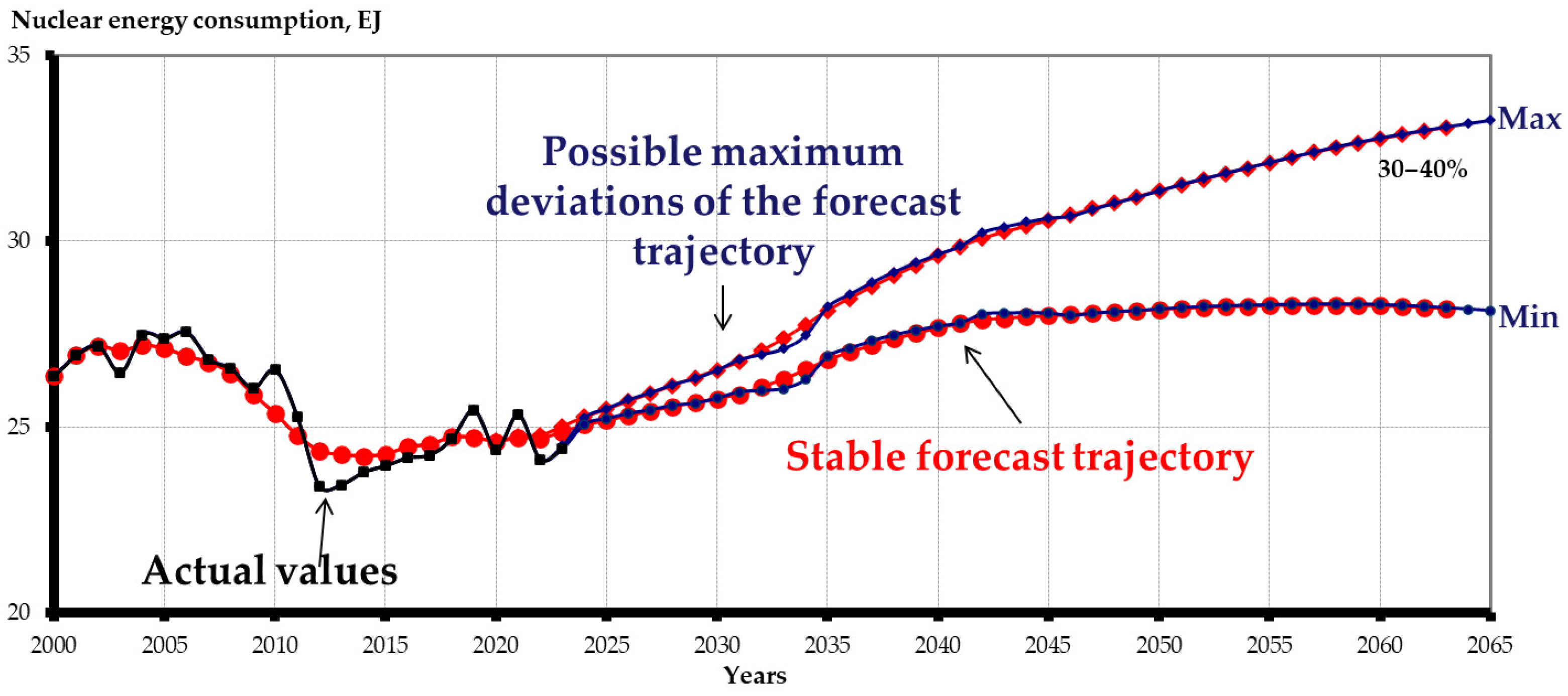



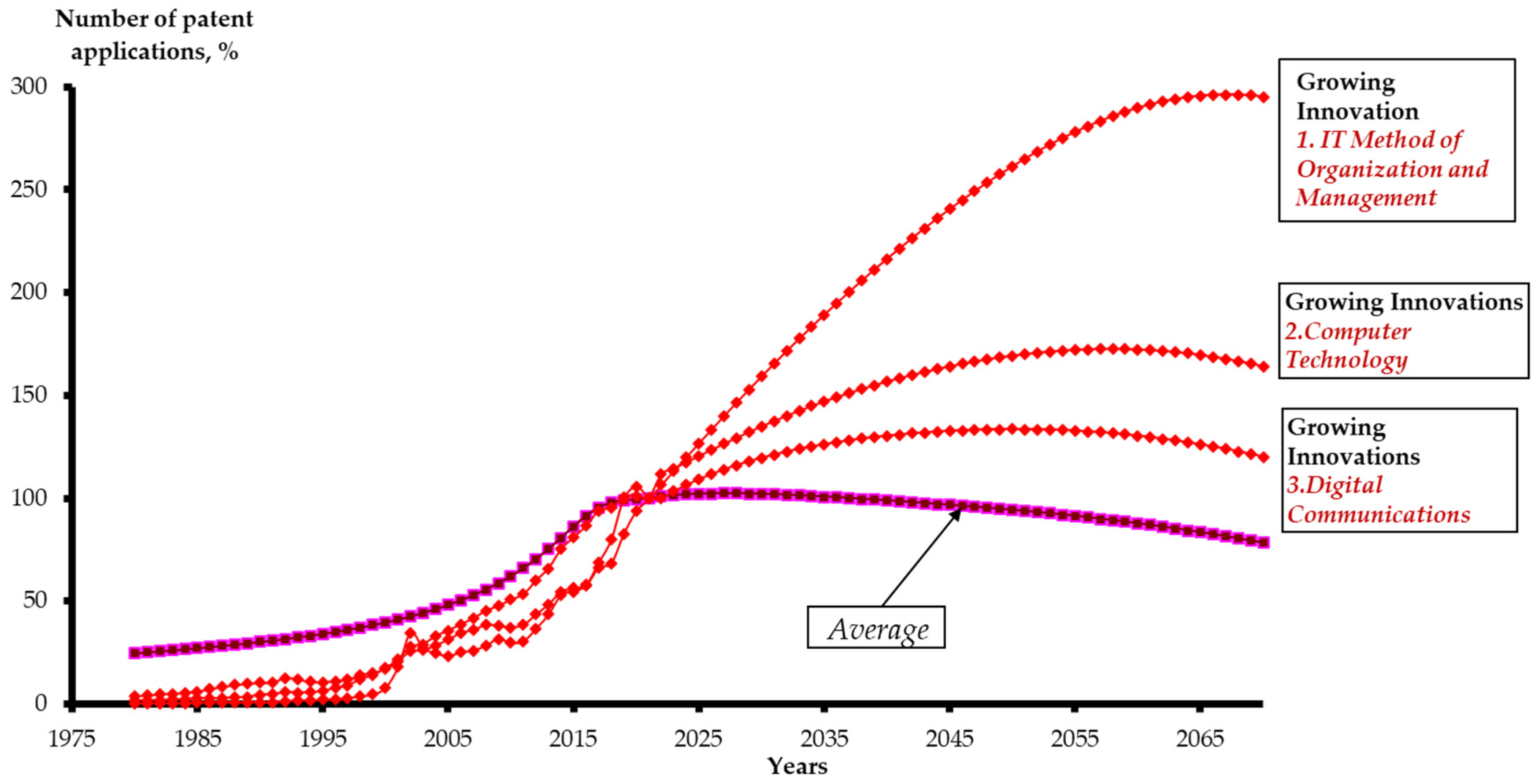



| Information Transfer from Node to Node | Information Transfer Physics Type | Root Mean Square Error | Determination Coefficient R2 (%) |
|---|---|---|---|
| 1. Coal consumption model | |||
| Inside layer | Logistic | 0.09 | 79 |
| Between layers | Logistic | 0.08 | 82 |
| Output layer | Logistic | 0.07 | 83 |
| 2. Oil consumption model | |||
| Inside layer | Logistic | 0.15 | 83 |
| Between layers | Logistic | 0.12 | 85 |
| Output layer | Logistic | 0.11 | 82 |
| 3. Gas consumption model | |||
| Inside layer | Logistic | 0.13 | 81 |
| Between layers | Logistic | 0.16 | 78 |
| Output layer | Logistic | 0.14 | 80 |
| 4. Energy consumption model | |||
| Inside layer | Logistic | 0.10 | 80 |
| Between layers | Logistic | 0.13 | 82 |
| Output layer | Logistic | 0.12 | 83 |
| Types of Training | 1. Coal Consumption Model | 2. Oil Consumption Model | 3. Gas Consumption Model | 4. Energy Consumption Model |
|---|---|---|---|---|
| Root Mean Square Error | ||||
| Direct | 0.10 | 0.13 | 0.11 | 0.12 |
| Reverse | 0.14 | 0.15 | 0.14 | 0.16 |
| Developed Models | Relative Standard Deviation from the Model, CV (%) | ||
|---|---|---|---|
| Developed MLP Forecasting Model | BP | IEA | |
| 1. Coal consumption model | 17 | 13 | 15 |
| 2. Oil consumption model | 15 | 14 | 18 |
| 3. Gas consumption model | 19 | 21 | 20 |
Disclaimer/Publisher’s Note: The statements, opinions and data contained in all publications are solely those of the individual author(s) and contributor(s) and not of MDPI and/or the editor(s). MDPI and/or the editor(s) disclaim responsibility for any injury to people or property resulting from any ideas, methods, instructions or products referred to in the content. |
© 2025 by the authors. Licensee MDPI, Basel, Switzerland. This article is an open access article distributed under the terms and conditions of the Creative Commons Attribution (CC BY) license (https://creativecommons.org/licenses/by/4.0/).
Share and Cite
Plakitkin, Y.A.; Tick, A.; Plakitkina, L.S.; Dyachenko, K.I. Global Energy Trajectories: Innovation-Driven Pathways to Future Development. Energies 2025, 18, 4367. https://doi.org/10.3390/en18164367
Plakitkin YA, Tick A, Plakitkina LS, Dyachenko KI. Global Energy Trajectories: Innovation-Driven Pathways to Future Development. Energies. 2025; 18(16):4367. https://doi.org/10.3390/en18164367
Chicago/Turabian StylePlakitkin, Yuri Anatolyevich, Andrea Tick, Liudmila Semenovna Plakitkina, and Konstantin Igorevich Dyachenko. 2025. "Global Energy Trajectories: Innovation-Driven Pathways to Future Development" Energies 18, no. 16: 4367. https://doi.org/10.3390/en18164367
APA StylePlakitkin, Y. A., Tick, A., Plakitkina, L. S., & Dyachenko, K. I. (2025). Global Energy Trajectories: Innovation-Driven Pathways to Future Development. Energies, 18(16), 4367. https://doi.org/10.3390/en18164367











